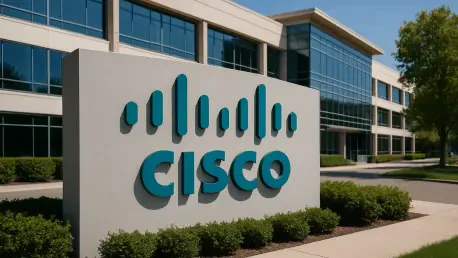In the dynamic realm of technology, a staggering $300 billion is projected to be invested by hyperscale giants like Microsoft, AWS, and Google into data center infrastructure over the next 12 months, spotlighting the critical role of AI in reshaping global markets. Amid this unprecedented surge, Cisco Systems has carved out a remarkable achievement by doubling its AI sales target to over $2 billion in the current fiscal year, a feat that underscores its strategic relevance in powering the backbone of AI-driven innovation. This analysis delves into the market trends, competitive dynamics, and financial underpinnings that have fueled Cisco’s success, while also projecting future trajectories in the rapidly evolving networking and AI infrastructure sectors. The purpose is to unpack the implications of this milestone for industry stakeholders and to forecast how Cisco might sustain its momentum in a fiercely competitive landscape.
Decoding the AI Infrastructure Surge: Market Trends and Dynamics
Hyperscaler Investments: Catalysts of Unprecedented Growth
The AI infrastructure market is experiencing explosive growth, driven primarily by hyperscalers whose massive investments are redefining the scale of data center expansion. With a planned expenditure of $300 billion in the coming year, companies like Microsoft, AWS, and Google are at the forefront, necessitating robust networking solutions to support intensive AI workloads. Cisco has capitalized on this trend, securing over $2 billion in AI-related orders, a figure that, while significant, represents just a sliver of the broader market dominated by competitors like Nvidia with quarterly networking sales of $5 billion. This disparity highlights the immense opportunity and challenge for Cisco as it seeks to expand its foothold among these titans of tech.
Competitive Landscape: Positioning Against Industry Giants
Navigating the competitive terrain, Cisco faces formidable rivals who have established strongholds in AI hardware and networking. Unlike Nvidia, which commands a significant share of the market with its cutting-edge offerings, Cisco’s strength lies in its expertise in connectivity and custom silicon solutions tailored for data center needs. This niche has allowed the company to contribute approximately a third of its $2.9 billion annual revenue growth through AI sales, signaling a strategic pivot toward high-demand sectors. However, the risk of hyperscalers developing in-house solutions or turning to other vendors looms large, pressing Cisco to continuously innovate to maintain its relevance.
Emerging Enterprise Demand: A Gradual but Promising Shift
Beyond the hyperscaler domain, the market is witnessing a slower but noteworthy trend of AI adoption among enterprises, which promises to be the next frontier for growth. Sectors such as retail are beginning to explore pilot projects, with expectations of broader agentic AI implementations in the latter part of the year, driving demand for enhanced network capacity and low latency. Cisco is well-positioned to meet these needs, as evidenced by double-digit order growth in its on-premise networking segment for four consecutive quarters, though the pace of enterprise uptake may be tempered by budget constraints and integration complexities compared to the rapid adoption seen among web-scale clients.
Financial Foundations: Cisco’s Stability Amid Market Expansion
Robust Quarterly and Annual Performance Metrics
Underpinning Cisco’s market achievements is a solid financial foundation that provides the stability needed to pursue ambitious AI initiatives. In the fourth quarter, the company reported an 8% year-on-year revenue increase to $14.7 billion, accompanied by a striking 31% surge in net income to $2.8 billion. For the full fiscal year, revenue reached $56.7 billion, with net income inching up 1% to $10.5 billion, reflecting resilience across its diversified portfolio of networking, security, and collaboration products. This financial health offers a buffer against competitive pressures and supports sustained investment in emerging technologies.
Innovation as a Growth Driver: New Product Traction
A key element of Cisco’s market strategy is its focus on innovation, with new offerings gaining traction among customers. Products like the Catalyst 9000 switches, powered by custom silicon, and the Hypershield security solution, with early sales of 80 units, demonstrate the company’s ability to address evolving market needs. These innovations not only bolster Cisco’s competitive edge but also contribute to its revenue growth, providing a glimpse into potential future streams as AI and networking demands continue to converge. Balancing these emerging products with core business lines remains critical to long-term success.
Economic and Regulatory Factors: Minimal Disruptions
External factors such as potential U.S. tariffs have shown little impact on Cisco’s market performance, with no evidence of customers accelerating purchases to preempt cost increases. Additionally, robust government spending, projected to rise by 2026, offers a supportive backdrop for growth, particularly in the U.S. market. While economic or regulatory shifts could pose challenges down the line, the current stability allows Cisco to focus on strategic priorities like expanding its AI infrastructure offerings and preparing for broader enterprise adoption without immediate external pressures.
Future Projections: Navigating AI and Networking Horizons
Revenue Forecasts and Growth Expectations
Looking ahead, Cisco projects revenue for the next fiscal year to range between $59 billion and $60 billion, indicating a growth rate of 4.0% to 5.8%. This forecast reflects confidence in sustained demand from both hyperscalers and emerging enterprise sectors, bolstered by the company’s diversified product suite. The projected uptick suggests that Cisco anticipates maintaining its upward trajectory, leveraging its current AI sales momentum to capture a larger share of the infrastructure market over the next couple of years.
Strategic Focus Areas: Hybrid Cloud and Edge Computing
Market analysts anticipate that Cisco’s future growth will hinge on its ability to integrate solutions for hybrid cloud and edge computing, areas where AI workloads are expected to proliferate. These domains represent significant opportunities as enterprises increasingly seek flexible, scalable networking solutions to support distributed AI applications. By prioritizing advancements in these fields, Cisco could further differentiate itself from competitors, ensuring relevance as the market evolves toward more decentralized and dynamic infrastructure needs.
Potential Challenges and Market Risks
Despite optimistic projections, several risks could influence Cisco’s market position, including the potential for hyperscalers to shift toward alternative providers or in-house technologies. Additionally, slower-than-expected enterprise AI adoption due to financial or technical barriers may delay anticipated growth in that segment. Cisco must remain agile, continuously refining its offerings and partnerships to mitigate these risks while capitalizing on the broader trend of AI-driven transformation across industries.
Reflecting on Cisco’s Market Journey
Looking back, Cisco’s remarkable achievement of doubling its AI sales target to over $2 billion stands as a testament to its strategic alignment with hyperscaler demand, supported by a robust financial performance that saw annual revenue hit $56.7 billion. The company’s ability to secure a foothold in a market dominated by giants like Nvidia, coupled with early success in innovative products, marked a pivotal moment in its trajectory. For industry stakeholders, the key takeaway is the importance of targeting high-growth sectors while maintaining financial stability to fund innovation. Moving forward, Cisco needs to deepen its focus on hybrid cloud and edge computing solutions to stay ahead of market shifts. Additionally, fostering tailored offerings for enterprises could unlock long-term gains as AI adoption broadens. These strategic steps, if executed effectively, promise to solidify Cisco’s standing in the ever-evolving technology landscape.









